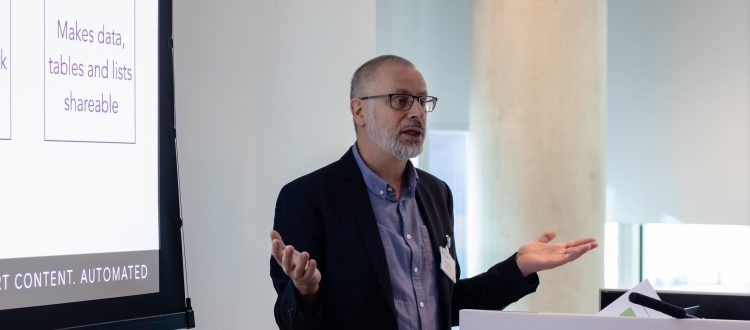Robot journalism drives subscriptions
By Joanne Kuai
“Record-breaking high price home sold in your city!” “Your local football team won 7:0 at the championship!” How do you know? Your robot journalists bring you the latest news!
United Robots CEO Karlsson introduces how their automated content bots are writing up automatic real estate listings and thousands of sports texts every week, which has driven waves of traffic and subscribers to their partner publishers.
Speaking on Friday in London at the 8thData & AI for Media Conference, Karlsson said while every news organization is working on personalization for their readers, the solution cannot be hiring more people to the newsroom, but automation. “It saves costs and drives revenues!”
The company based in Sweden and its local publishing partners have shown impressive results in readership growth using robot journalism. Karlsson cites an example of its partnership with MittMedia: in eight months, the robots have generated 26,000 stories, driving 2.7 million paying visits and achieved a conversation rate of 3%.
Real estates, sports among some other topics have been deemed more suitable for robot journalism, as journalists are still needed to cover more complex stories and editorial choices are still important when it comes to controversial topics or more delicate subjects. “Continuous flow” is also crucial, as “the robots could cover elections, but it’s just one day in every four years and it’s not economically feasible”.

Crisis or opportunities?
A veteran journalist himself with more than 20 years of experience covering various topics locally in his hometown in Sweden, Karlsson believes robot journalism is not a threat but an opportunity to the journalists: “It frees the journalists to focus on more important stories, conduct investigative reporting, and helps with real quality journalism.”
Another function, which sends out alters when the computers notice something out of the ordinary happens by identifying an outliner in the data set, it helps the newsroom to find hidden stories. What’s more, machines are also much better and quicker in automatically generate summaries.
While many are curious whether the robot journalism involves machine-learning, Karlsson says no. He reveals there are templates of pre-defined sentences or parts of the sentences with the use of some algorithms. “We are also focusing on improving the quality of the texts and making variations to the text,” says Karlsson.

While the tech company is working on making the automatically-generated texts “feel as smooth as possible and do not sound like a machine”, the decision on whether to let their readers know what they are reading is not written by a human is entirely up to the publishers themselves. In fact, data shared by United Robots indicates that 60% of the tested readers didn’t notice the texts were generated by robots and the rest just didn’t care.
Started three years ago, United Robots’ business has yielded tremendous results locally and has now partnered with almost all the Swedish newspaper. The company hopes to expand its business worldwide. Karlsson said their robots have been generating text in Swedish, English and Finnish and they are developing the function in more languages to better reach the global market.


